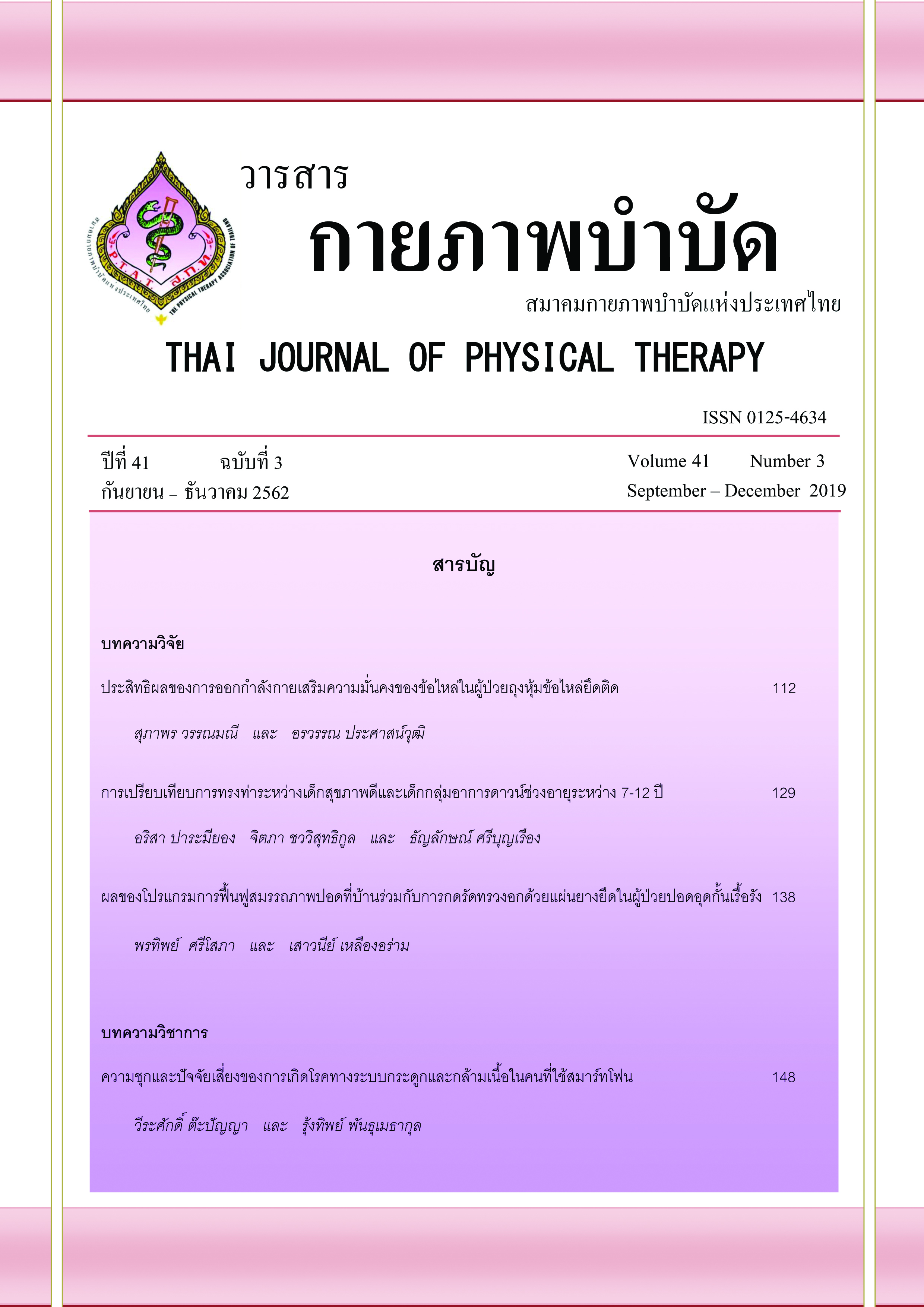การเปรียบเทียบการแกว่งของร่างกายระหว่างเด็กสุขภาพดีและเด็กกลุ่มอาการดาวน์ช่วงอายุระหว่าง 7-12 ปี
Main Article Content
บทคัดย่อ
ที่มาและความสำคัญ: การควบคุมการทรงท่าเป็นปัจจัยที่มีความสำคัญต่อพัฒนาการในเด็กเป็นอย่างมาก เด็กกลุ่มอาการดาวน์มีลักษณะบกพร่องของการควบคุมการทรงท่าส่งผลให้มีพัฒนาการการเคลื่อนไหวที่ล่าช้า ปัจจุบันการประเมินการทรงตัวด้วยการวัดการแกว่งของร่างกายโดยใช้เครื่อง swaymeter เป็นวิธีที่ง่าย เหมาะกับการนำไปใช้ในคลินิกหรือชุมชน
วัตถุประสงค์: เพื่อเปรียบเทียบตัวแปรของการแกว่งของร่างกายซึ่งประเมินด้วย swaymeter ระหว่างเด็กกลุ่มอาการดาวน์และเด็กสุขภาพดีช่วงอายุระหว่าง 7-12 ปีและเปรียบเทียบผลของการรบกวนการมองเห็นต่อการแกว่งของร่างกายของเด็กทั้งสองกลุ่ม
วิธีการวิจัย: ผู้เข้าร่วมการศึกษาประกอบด้วยเด็กสุขภาพดี 25 คน และเด็กกลุ่มอาการดาวน์ 21 คนประเมินตัวแปรการแกว่งของร่างกายโดยใช้ swaymeter ได้แก่การแกว่งในทิศทางหน้า-หลัง (anteroposterior; AP) ด้านข้าง (mediolateral; ML) และพื้นที่การแกว่งโดยทดสอบในท่ายืน ขณะลืมตาและหลับตา สภาวการณ์ละ 30 วินาที
ผลการวิจัย: เด็กกลุ่มอาการดาวน์มีการแกว่งของร่างกายมากกว่ากลุ่มเด็กสุขภาพดีอย่างมีนัยสำคัญทางสถิติ ในขณะลืมตา การแกว่งในทิศ AP (p = 0.002), ML (p = 0.003) และพื้นที่การแกว่งค่า (p = 0.001) ส่วนขณะหลับตาค่า p < 0.001 ในทุกตัวแปร การรบกวนการมองเห็นส่งผลให้ตัวแปรการแกว่งของร่างกายในเด็กกลุ่มอาการดาวน์เพิ่มขึ้นอย่างมีนัยสำคัญทางสถิติในทิศ AP, ML และพื้นที่การแกว่ง (p = 0.001) ส่วนเด็กสุขภาพดีไม่พบความแตกต่าง
สรุปผล: เด็กกลุ่มอาการดาวน์มีความไม่มั่นคงของการทรงท่าโดยมีการแกว่งของร่างกายและพึ่งพาข้อมูลจากการมองเห็นในการทรงท่ามากกว่าเด็กสุขภาพดี
Article Details
เอกสารอ้างอิง
2. Horak FB. Postural orientation and equilibrium: what do we need to know about neural control of balance to prevent falls?. Age Ageing. 2006;35 Suppl 2:ii7-ii11.
3. Galli M, Rigoldi C, Mainardi L, Tenore N, Onorati P, Albertini G. Postural control in patients with Down syndrome. Disabil Rehabil. 2008;30(17):1274-8.
4. Rigoldi C, Galli M, Mainardi L, Crivellini M, Albertini G. Postural control in children, teenagers and adults with Down syndrome. Res Dev Disabil. 2011;32(1):170-5.
5. Hsu YS, Kuan CC, Young YH. Assessing the development of balance function in children using stabilometry. Int J Pediatr Otorhinolaryngol. 2009;73(5):737-40.
6. Figura F, Cama G, Capranica L, Guidetti L, Pulejo C. Assessment of static balance in children. J Sports Med Phys Fitness. 1991;31(2):235-42.
7. Duarte M, Freitas S, Zatsiorsky V. Control of equilibrium in humans: sway over sway. In: Danion F, Latash ML, Eds. Motor control. Oxford University Press. 2011:219-42.
8. Villarroya MA, Gonzalez-Aguero A, Moros-Garcia T, de la Flor Marin M, Moreno LA, Casajus JA. Static standing balance in adolescents with Down syndrome. Res Dev Disabil. 2012;33(4):1294-300.
9. Lord SR, Menz HB, Tiedemann A. A physiological profile approach to falls risk assessment and prevention. Phys Ther. 2003;83(3):237-52.
10. Parameyong A, Boripuntakul S, Kamnardsiri T, Chawawisuttikool J. The Validity and reliability of the Swaymeter for postural sway measurement in typically developing children aged between 7-12 years. Gait Posture. 2018; 66: 273-77.
11. Parameyong A, Boripuntakul S, Chawawisuttikul J. Test-retest reliability of balance assessment using Swaymeter in children with Down syndrome aged 7-12 years. Journal of Associated Medical Sciences. 2017;50:253-61.
12. Latash ML. Motor control in Down syndrome: The role of adaptation and practice. J Dev Phys Disabil. 1992;49(3): 227-61.
13. Latash ML, Anson JG. What are “normal movements” in atypical populations? Behav Brain Sci. 1996; 19(1): 55-68.
14. Woollacott MH, Shumway-Cook A. Changes in posture control across the life span-a systems approach. Phys Ther. 1990; 70(12):799-807.
15. Maiano C, Hue O, Tracey D, Lepage G, Morin AJS, Moullec G. Static postural control among school-aged youth with Down syndrome: A systematic review. Gait Posture. 2018; 62: 426-33.
16. Meneghetti C, Blascovi-Assis S, Deloroso F, Rodrigues G. Avaliação do equilíbrio estático de crianças e adolescentes com síndrome de Down. Braz J Phys Ther. 2009;13:230-5.
17. Horak FB, Nashner LM. Central programming of postural movements: adaptation to altered support-surface configurations. J Neurophysiol. 1986; 55(6):1369-81.
18. Wang HY, Long IM, Liu MF. Relationships between task-oriented postural control and motor ability in children and adolescents with Down syndrome. Res Dev Disabil. 2012; 33(6):1792-8.
19. Geldhof E, Cardon G, De Bourdeaudhuij I, Danneels L, Coorevits P, Vanderstraeten G, et al. Static and dynamic standing balance: test-retest reliability and reference values in 9 to 10 year old children. Eur J Pediatr. 2006;165(11):779-86.
20. Lee AJ, Lin WH. The influence of gender and somatotype on single-leg upright standing postural stability in children. J Appl Biomech. 2007;23(3):173-9.
21. Nolan L, Grigorenko A, Thorstensson A. Balance control: sex and age differences in 9- to 16-year-olds. Dev Med Child Neurol. 2005; 47(7):449-54.
22. Peterson ML, Christou E, Rosengren KS. Children achieve adult-like sensory integration during stance at 12-years-old. Gait Posture. 2006; 23(4):455-63.


